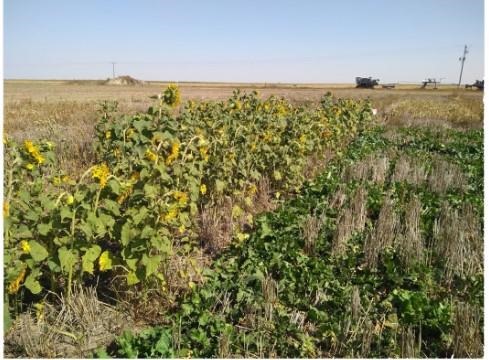By Katja Koehler-Cole
Many of us may have heard the term “Nature abhors a vacuum” (Aristotle) and we can see the effects of that when a field is left fallow — for example, after winter wheat harvest. Instead of tillage or herbicides to control the weeds that will try to fill this “vacuum”, a warm-season cover crop can be planted. Not only will the cover crop suppress weeds, but it also improves living conditions for the organism below-ground and above-ground. Many warm-season cover crop species are available and can be used for different purposes, such as improving soil health, breaking up soil compaction, providing forage and supporting beneficial insects.
In a study carried out at the South Central Agricultural Laboratory (SCAL) near Clay Center in 2019 and 2020, we tested the productivity of 10 different cover crop species under dryland conditions. Productivity was measured as above-ground biomass (on a dry matter basis) because biomass production is linked to how well a cover crop will fulfill its purpose. We included fast-growing summer annuals: buckwheat (Fagopyrum esculentum) and sunflower (Helianthus annuus), which attract many pollinating insects, sorghum-sudangrass (Sorghum × drummondi) and pearl millet (Pennisetum glaucum) for grazing, and the legumes sunnhemp (Crotalaria juncea) and cowpea (Vigna unguiculata), for N fixation. We also grew cool-season species: the brassicas purple-top turnip (Brassica rapa) and radish (Raphanus sativus), for their ability to break up soil compaction layers, and the legumes hairy vetch (Vicia villosa) and crimson clover (Trifolium incarnatum) for N fixation. All species, except hairy vetch and crimson clover, winterkill in Nebraska, eliminating the need for termination and leaving time to refill the soil water profile before the next crop.
Table 1. Seeding rates in lb/ac for the cover crop species.| Cover crop species | Seed in lb/ac |
|---|
| Buckwheat | 35 |
| Cowpea | 60 |
| Crimson clover | 20 |
| Hairy vetch | 20 |
| Pearl millet | 15 |
| Radish | 10 |
| Sorghum-sudan | 30 |
| Sunflower | 10 |
| Sunnhemp | 20 |
| Turnip | 3 |
Each species was planted by itself, by no-till drilling in 7.5-inch rows into winter wheat stubble. Seeding rates are given in Table 1. In 2019, cover crops were planted Sept. 4 and biomass production was measured Oct. 11. In 2020, cover crops were planted July 21 and biomass was sampled Sept. 24. Biomass production was measured by clipping all above-ground plant material, then drying and weighing it. We compared average biomass production among species and show this data in Figure 1.
Sunflower, radish and sorghum-sudangrass were the most productive cover crops (see Figure 1 and 2), with over 2,000 lb/ac of biomass. Sunnhemp, buckwheat, pearl millet and turnip produced moderate amounts of biomass, between 1,100 and 1,300 lb/ac. The legumes cowpea, hairy vetch and crimson clover were least productive, with only 500 to 800 lb/ac of biomass. How much biomass is that? Sunflowers, sorghum-sudangrass, sunnhemp, pearl millet and buckwheat were three to four feet tall, whereas the other species were one to two feet tall (see Figure 3). Biomass production and thus height of cover crops may be greater in areas with higher precipitation such as eastern Nebraska or where cover crops are irrigated.

Figure 1. Biomass production (average of 2019 and 2020) of 10 summer-planted cover crops. Sunflower, sorghum-sudangrass, sunnhemp, buckwheat, pearl millet and cowpea are warm-season annuals, whereas the other species are cool-season cover crops.
Figure 2. (From left) Sorghum-sudangrass, sunflower, radish and sunnhemp on Oct. 7, 2020 in the plots at SCAL. Frost had already killed the tropical species sorghum-sudangrass and sunnhemp.Due to our relative late planting, no cover crop flowered in 2019, but in 2020, sunflower, sunnhemp and buckwheat had flowers. Buckwheat, in particular, was buzzing with insects, providing a source of nectar and pollen to bees, bumblebees and butterflies at a time when little food is available to them (see Figure 4).

Figure 3. Sunflower on the left and turnips on the right; picture taken Oct. 7, 2020 at SCAL.
Figure 4. Monarch butterfly (Danaus plexippus) feeding on a buckwheat flower. Picture taken on Aug. 10, 2021, in a cover crop field in Lincoln, Nebraska.We did not mix our species, but in reality, most growers will use a cover crop mix when planting in the summer. To achieve high biomass — for example, for grazing, to shade out weeds, for erosion protection or to add organic matter to the soil — the mix should include productive species such as sorghum-sudangrass, sunflower and radish. Pearl millet and turnip are a little less aggressive but still have good growth and palatable forage. They may be more appropriate in situations where less biomass is desired. Flowering broadleafs, especially buckwheat, will attract many beneficial insects. Adding sunnhemp to a mix could provide some N to the system; however, cowpea, hairy vetch and crimson clover are unlikely to be good N sources, because of their minimal growth. Planting these species together could yield more overall biomass, as the lower-growing species can establish under the taller species, which also support cowpea and hairy vetch vines.
Selecting an appropriate summer cover crop can replace the “vacuum” left after the harvest of early-maturing crops with a useful, vibrant, low-maintenance cover crop. Sunflower, sorghum-sudangrass, radish, sunnhemp, buckwheat, pearl millet and turnip would be good options for Nebraska dryland conditions, either grown by itself or in a mix of species.
Source : unl.edu